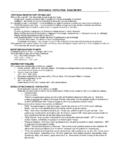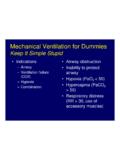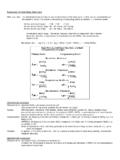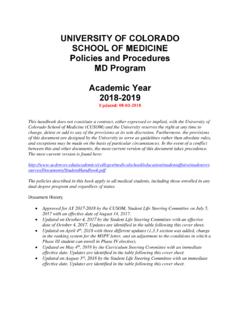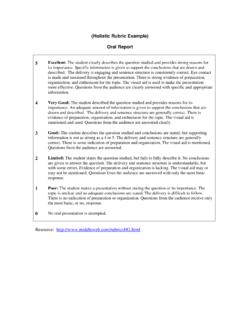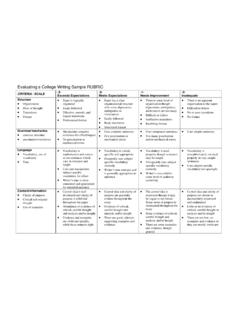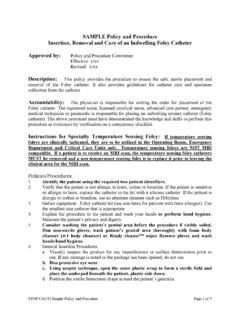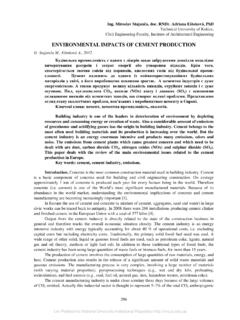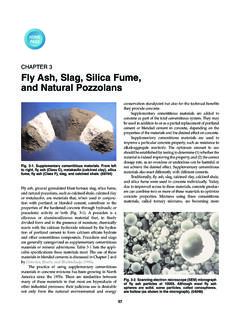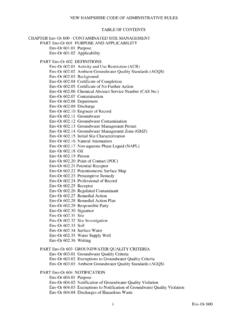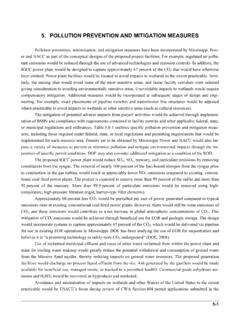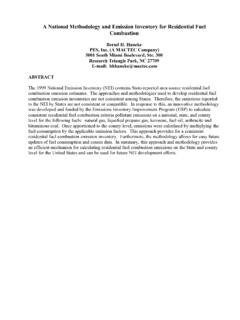Transcription of Pumped Storage Hydropower: A Technical Review
1 Pumped Storage hydropower : A Technical Review Brandi A. Antal , University of Colorado Boulder, 2004. A Master Report Submitted to Department of Civil Engineering University of Colorado Denver In partial fulfillment of the requirements for the degree of Masters of Science in the area of Hydrologic and Hydraulic Engineering May 2014. 1. Pumped Storage hydropower : A Technical Review Submitted by Brandi A. Antal Approved and Signed by _____. Dr. David Mays, Assistant Professor _____. Dr. Indrani Pal, Assistant Professor _____. Dr. James Guo, Professor _____. Date 2. Executive Summary Pumped Storage hydropower is a technology that stores low-cost off-peak, excess, or unusable electrical energy. Historically, it was used in the United States to meet fluctuating power demands in conjunction with nuclear power plants. As renewable energy sources such as wind and solar are increasingly integrated onto the power grid, Pumped Storage hydropower is again gaining recognition as an effective power Storage technology.
2 Due to the age of existing Pumped Storage projects in the United States, these plants utilize single speed units. Advancements in pump/turbine unit technology have resulted in the development of adjustable speed units, which are used in the majority of newly planned Pumped Storage hydropower projects. In this paper, a new model is presented that evaluates the operational characteristics of Pumped Storage hydropower systems for planning purposes. The model assumes a typical off- stream Pumped Storage hydropower project, with the overall objective of obtaining an accurate, early prediction of the performance of a Pumped Storage hydropower project. The model is particularly suited for comparison of single speed units versus adjustable speed units. This tool can be useful during the planning phase to quickly evaluate various Technical parameters and select the most appropriate pump/turbine unit type and size. 3. TABLE OF CONTENTS. Executive Summary .. 3. 1. Introduction .. 7. Background and 8.
3 Types of Power Plants and Power Demand Versus Time .. 8. Renewable Technologies .. 11. Energy Storage .. 13. 2. Power and Energy Equations .. 16. Energy .. 16. Efficiencies .. 17. Power .. 17. 3. History of Pumped Storage hydropower Projects .. 19. 4. Pumped Storage hydropower Technical Overview .. 21. Cycle Efficiencies .. 25. Disadvantages Associated with Pumped Storage hydropower Projects .. 27. Operation of Pumped Storage hydropower Projects .. 28. 5. Pump/Turbine Technology .. 30. Pump/Turbine Configuration .. 30. Single Speed Units (Conventional Pumped Storage hydropower ) .. 31. Adjustable Speed Units .. 31. 6. Case Studies of Adjustable Speed Pumped Storage hydropower .. 37. 7. Design Considerations .. 40. Head .. 40. Flow Rates .. 40. Waterway .. 41. Upper and Lower Reservoirs .. 41. Pump/Turbine Selection .. 44. 8. Technical Analysis .. 45. Objective .. 45. 45. Power Supply and Demand .. 47. Efficiency of Project Components .. 48. Pumping and Generating Mode .. 49. Results and 59.
4 9. Costs of Pumped Storage hydropower .. 64. 4. Cost 64. Initial Capital Costs .. 64. Operation and Maintenance Costs .. 66. 10. Summary .. 68. 11. References .. 69. 71. LIST OF FIGURES. Figure 1. System Demand Curve Sample Day (Hultholm, 2014).. 10. Figure 2. Instantaneous Power for a Sample Wind Farm in Canada 76 Turbines (Ibrahim et al, 2007) . 12. Figure 3. Different Energy Storage Techniques Energy Stored and Power Output (Ibrahim et al, 2007).. 15. Figure 4. hydropower plant system Illustrates energy in the system (Chen, 1990) .. 18. Figure 5. Existing Pumped Storage hydropower Projects in the United States (Miller and Winters, 2009).. 20. Figure 6. Typical Pumped Storage hydropower Project Configuration (Miller and Winters, 2009) .. 21. Figure 7. Pure or Off-Stream Pumped Storage hydropower (Deane et al, 2010) .. 24. Figure 8. Pump-Back Pumped Storage hydropower Configuration (Deane et al, 2010) .. 24. Figure 9. Cycle Efficiencies for Pumped Storage hydropower Projects in the United States (MWH, 2009).
5 25. Figure 10. Turbine Efficiency Versus Rated Power Output (MWH, 2009) .. 27. Figure 11. Operation of Daily Cycle Pumped Storage hydropower Project (USACE, 1985) .. 29. Figure 12. Operation of Weekly Cycle Pumped Storage hydropower Project (USACE, 1985) .. 29. Figure 13. Comparison of Single Speed and Adjustable Speed Electrical Connections (Kuwabara et al, 1996) .. 33. Figure 14. Operating Range of Pumps Single Speed Versus Adjustable Speed .. 34. Figure 15. Comparison of Pump/Turbine Efficiencies - Single Speed Pump/Turbine (MWH, 2009) .. 35. Figure 16. Comparison of Pump/Turbine Efficiencies Adjustable Speed Pump/Turbine (MWH, 2009) 35. Figure 17. Operation of Single Speed and Adjustable Speed Pump/Turbine Units in Pumping Mode (Kunz et al, 2012) .. 36. Figure 18. Simplified Pumped Storage hydropower Project Configuration .. 46. Figure 19. Energy Supply and Demand - Case 3 .. 48. Figure 20. Operation During Pumping Mode Lorella Pumped Storage hydropower Project .. 60. Figure 21.
6 Operation During Pumping Mode - Iowa Hill Pumped Storage hydropower Project .. 61. Figure 22. Operation During Pumping Mode - Eagle Mountain Pumped Storage hydropower 61. Figure 23. Operation During Generating Mode Lorella Pumped Storage hydropower Project .. 63. Figure 24. Operation During Generating Mode - Iowa Hill Pumped Storage hydropower Project .. 63. 5. Figure 25. Operation During Generating Mode - Eagle Mountain Pumped Storage hydropower Project 63. Figure 26. Capital Costs for Sample Projects in the United States (Deane et al, 2009) .. 66. LIST OF TABLES. Table 1. The response of sudden changes for some power plants (Dursun and Alboyaci, 2009).. 11. Table 2. Typical Operating Characteristic of Generating Plant (Deane et al, 2010) .. 11. Table 3. Existing Pumped Storage hydropower Projects in the United States (MWH, 2009) .. 20. Table 4. Composition of Pumped Storage hydropower Plant Cycle Efficiency For Typical Projects with Single Speed Pump/Turbine Units (MWH, 2009).
7 26. Table 5. Case Studies of Proposed Adjustable Speed Pumped Storage hydropower 37. Table 6. Simplified Storage Equation Case 43. Table 7. Pumping Mode Model Results Energy Stored by Single Speed Versus Adjustable Speed Pump/Turbine Units .. 60. Table 8. Generating Mode Model Results Energy Generated by Single Speed Versus Adjustable Speed Pump/Turbine Units .. 62. LIST OF APPENDICES. Appendix A. Lorella Pumped Storage Project Layout (FFP, 2012) .. 72. Appendix B. Iowa Hill Pumped Storage Project Cross-Section (SMUD, 2013) .. 74. Appendix C. Eagle Mountain Pumped Storage Project Cross-Section (ECEC, 2009) .. 76. Appendix D. Pumped Storage hydropower Model Layout .. 78. 6. 1. Introduction As defined by the United States Army Corps of Engineers, Pumped Storage hydropower is a special type of hydropower development, in which Pumped water rather than natural streamflow provides the source of energy (USACE, 1985). In general terms, Pumped Storage hydropower is a technology that stores low-cost off-peak energy or excess or unusable energy (perhaps generated from renewable energy sources) for later use.
8 While Pumped Storage hydropower projects are a net consumer of electricity, they provide many useful power system operational benefits, including system Storage capacity and power grid ancillary services, which allow other types of electrical plants in the system to operate more efficiently. From the 1960s to the 1980s, Pumped Storage hydropower projects became popular in the United States and Japan as a way to meet fluctuating power demands in conjunction with nuclear power plants, which are unable to adjust to changing demands in a timely manner. Other countries such as Austria, which have no nuclear power plants, also constructed Pumped Storage hydropower projects to facilitate better operation of their key conventional hydropower plants (Deane et al, 2010). As renewable energy sources are integrated onto the power grid, Pumped Storage hydropower projects are again gaining international recognition as an effective power Storage technology. With the ever growing appeal of renewable energy sources, wind and solar plants are being developed worldwide.
9 Due to the unpredictable and sometimes intermittent nature of wind and solar power, Pumped Storage hydropower projects are a reliable fall back to compensate for the variability of wind and solar power, and to store excess or unusable energy from renewable sources, and therefore allow for the better integration of these types of renewable energy into the power grid. The majority of modern Pumped Storage hydropower projects use reversible pump/turbine units that act as both a pump and a turbine. Most projects in the United States were built over 30. years ago, before adjustable speed units were available; consequently they have single speed 7. units. Advancements in technology have resulted in the development of adjustable speed units. Consequently, the majority of new Pumped Storage hydropower projects utilize adjustable speed units. This paper will focus on the use of both single speed and adjustable speed units. This paper will also include the development of a model to evaluate the operational characteristics of Pumped Storage hydropower projects using single speed and adjustable speed pump/turbine units.
10 The report is organized as follows: the remained of Section 1 will provide an overview of Pumped Storage hydropower ; Section 2 will present power and energy equations;. Section 3 will provide a brief history of Pumped Storage hydropower projects, Section 4 will provide a Technical overview of Pumped Storage hydropower , Section 5 will discuss pump/turbine technology, Section 6 will provide case studies of proposed adjustable speed Pumped Storage hydropower projects in the United States, Section 7 will present design considerations, Section 8 will present the methods, results, and discussion of the Pumped Storage hydropower model, Section 9 will present cost characteristics, and Section 10 will include a summary of the report. Background and Motivation Why use Pumped Storage hydropower ? To understand why Pumped Storage hydropower projects are useful it is first important to develop a general understanding of other types of power plants and how the electrical grid is operated. Types of Power Plants and Power Demand Versus Time In the United States, conventional power sources have primarily consisted of coal and nuclear power plants; however there is a growing percentage of natural gas and renewables entering the market over the last ten years.
